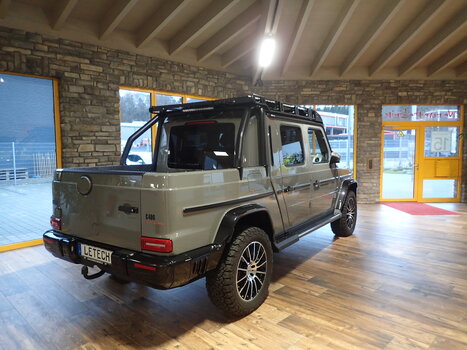It’s the stretch I like.
I’d have given up a little bit of offroad ability for a longer chassis and 20cm extra space in the back.
There are significant advantages to a longer wheelbase station wagon: (1) more storage that is both dry and secure (and maybe a higher payload), (2) ability to carry longer items inside the vehicle (avoiding a roof rack that raises the center of gravity, and can be tiresome to access regularly), (3) greater stability when towing (and maybe higher towing max.), (4) greater stability driving on snowy/slippery roads, and (5) its easier to sleep in a larger vehicle for those late-night arrivals at trailheads - especially when engaging in an Alpine start the following morning (yeah, yeah, get a roof top tent). The disadvantages are related to size on road (especially true in Europe and in urban America, but not a problem in rural America), and size off road.
The main problem for the LWB station wagon off road, is that the increased wheelbase reduces
breakover angle. In addition to this problem, the pickup truck will also suffer from reduced
departure angle. Folks new to off roading can see the image below for a glossary of these terms:
If the Long Wheel Base (LWB) version is engineered with forethought - in respect to the negative consequences of a longer wheelbase
off road - then the owner (should he or she wish) can fairly easily mitigate most of the disadvantages.
The way to resolve both issues (reduction to break over and departure angles) is to lift the suspension and add larger tires.
The current design of the Grenadier does not facilitate the addition of larger tires; here are the basic problems:
(1) The front control arms are short, so adding larger tires will negatively impact suspension geometry, degrading handling both on and off road. There are currently no long-arm kits for the Grenadier in the aftermarket (this may or may not change in the future).
(2) The wheel wells
seem to accommodate a 35-inch tire (based on a few photos), but it also looks like there would be rubbing when the suspension is flexed (hard to know without hearing from the Ineos drivers who have tested these, or without vehicles in the hands of the public).
(3) Vehicles need to be re-geared after a significant increase in tire-size. Nothing is currently known about the availability of alternate gears for the Carraro axles.
(4) Due to the two-door design in the rear, it is not going to be easy to carry a spare larger than 33-inches. A spare tire larger than 33-inches will block the opening of the small door (which must be opened before one can open the larger door). Perhaps the aftermarket will develop a spare tire carrier that attaches to the rear bumper, but then access to the back will require three steps: (a) open the tire carrier, (b) open the small door, (c) open the large door. If there were a single rear door, it could be engineered to carry a heavy tire or it could be integrated with a spare tire carrier that is bumper-mounted, so that you only open one thing to access the back. Here is my photo of the clearance between the stock spare (about 32-inches) and the small rear door:

There are some short-comings in the Jeep Wrangler and Jeep Gladiator pickup truck, but one thing that Jeep did really well, was recognize that people often move up in tire size. Here is how Jeep engineered the current version of the Wrangler (the JL, which was new in 2018) and the Gladiator with forethought - with regard to larger tires:
(1) The front control arms were lengthened between the previous (JK) and current (JL) versions of the Wrangler, and are also longer in the Gladiator.
(2) The wheel wells are huge, and can accommodate a 35-inch tire with no suspension lift; they accommodate a 37-inch tire with a 2-inch lift, and that lift is available from the factory.
(3) The axles in the Jeep are Dana axles, and there is a massive availability of both gears and differential lockers in the aftermarket for Dana axles. Even better, you can order an off-road package from the factory, that specs the vehicle with a 2-inch suspension lift, 35-inch tires, either 4.56 or 4.88 gears (your choice), and with a full-size spare. All under factory warranty.
(4) The Wrangler can carry a 37-inch spare on the back, and the aftermarket will sell you a tire carrier should you wish to carry a 40-inch tire (if that's your thing). The Gladiator can accommodate a 35-inch spare in the standard spare-location under the bed of the truck. You can get a bumper-mounted tire carrier for anything larger.
I understand that Ineos did not design the Grenadier to be a rock-crawler, and that running big tires was not their main goal. However, we have seen multiple Grenadiers being tested with 35-inch tires, so we know that 35s are on their radar. Ineos is making a vehicle that is superior to the Jeep products in many ways, but they should learn from what Jeep does well.
A LWB Grenadier, in station wagon form, with a suspension lift and 35-inch tires, would give up almost nothing off-road to a standard-length Grenadier running stock tires. We can have the benefits of a LWB wagon without giving up anything off road - if Ineos approaches the project with forethought, and engineers the vehicle in a way that "future-proofs" it for larger tires.





